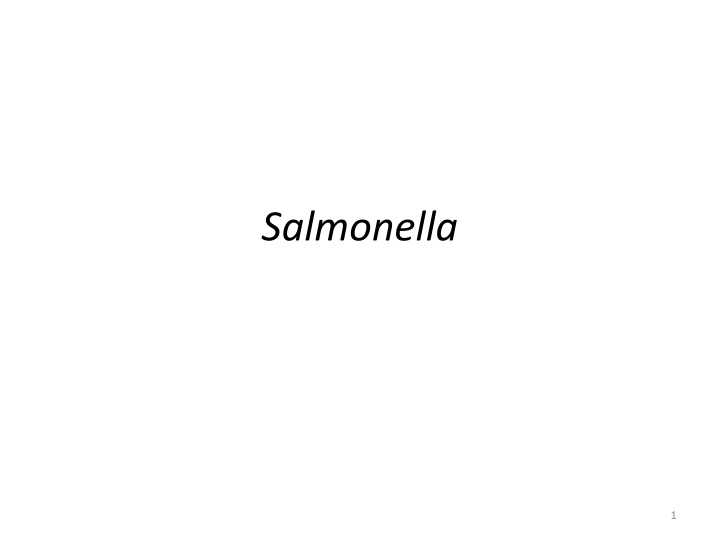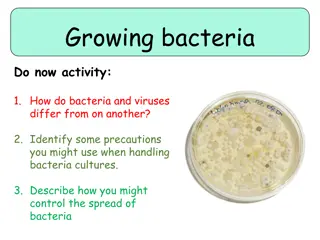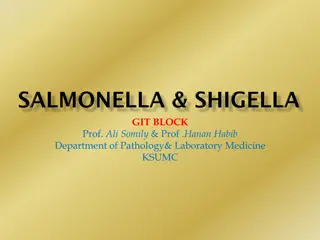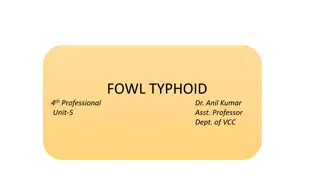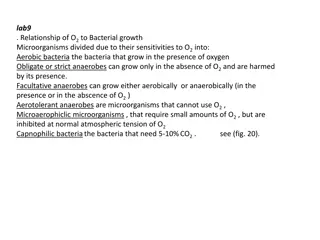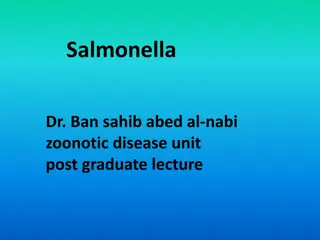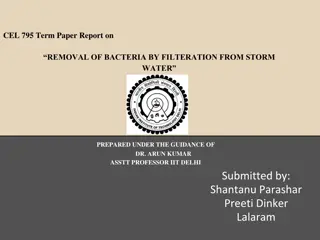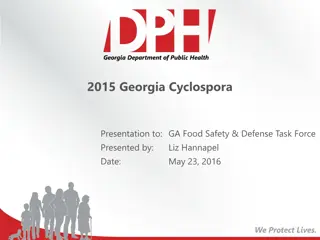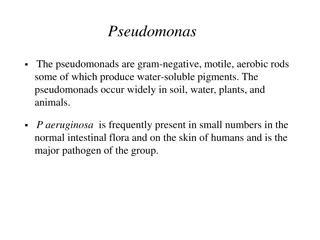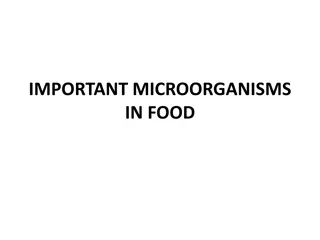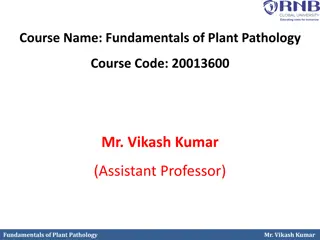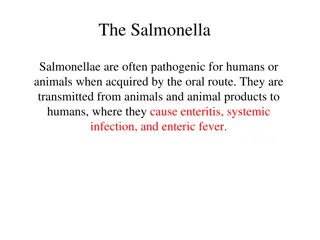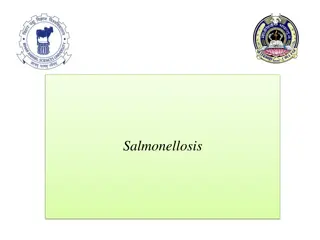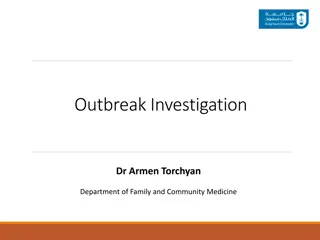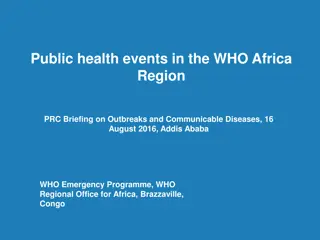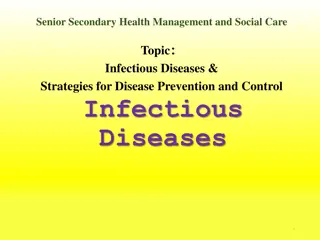Insights into Salmonella Bacteria and Outbreaks
Salmonella is a Gram-negative, rod-shaped bacterium that is commonly found in food and can cause infections in humans. It belongs to the Enterobacteriaceae family and has various subspecies with different characteristics and serovars. Understanding its nomenclature, growth characteristics, and common outbreaks is important for public health measures.
Uploaded on Sep 22, 2024 | 1 Views
Download Presentation

Please find below an Image/Link to download the presentation.
The content on the website is provided AS IS for your information and personal use only. It may not be sold, licensed, or shared on other websites without obtaining consent from the author.If you encounter any issues during the download, it is possible that the publisher has removed the file from their server.
You are allowed to download the files provided on this website for personal or commercial use, subject to the condition that they are used lawfully. All files are the property of their respective owners.
The content on the website is provided AS IS for your information and personal use only. It may not be sold, licensed, or shared on other websites without obtaining consent from the author.
E N D
Presentation Transcript
Characteristics of Salmonella enterica 2 Named after D. E. Salmon Enterobacteriaceae (many characteristics like E. coli) Gram negative rod, ~ 1 m in length. Facultative anaerobe Non-spore-forming Typically motile Lactose negative Forms H2S Is nationally notifiable http://en.wikipedia.org/wiki/Salmonella
Nomenclature of Salmonella 3 S. enterica Subspecies enterica (I), salamae (II), arizonae (IIIa), diarizonae (IIIb), houtenae (IV), indica (VI) S. bongori (V) Salmonella enterica subsp. enterica Salmonella enterica subsp. I
Serovar (serotype) designation 4 2,541 serovars, 1,504 are within S. enterica subsp. enterica Kauffman and White Salmonella enterica subsp. enterica 4,5,12 : i : 1,2 Salmonellaenterica subsp. enterica serovar Typhimurium ser. Typhimurium
Salmonella enterica subsp. enterica groups 5 Group Common O-antigen Examples Antigenic designation A 2 ser. Paratyphi A 1,2,12 : a : - B 4 ser. Typhimurium 1,4,5,12 : i : 1,2 C1 6 ser. Montevideo 6,7 : g,m,s : - C2 8 ser. Newport 6,8 : e,h : 1,2 D 9 ser. Enteritidis 1,9,12 : g,m : - E 3, 10, 15, 19 ser. Senftenberg 1,3,19 : g,s, t: - F 11 ser. Aberdeen 11 : i : 1,2 G 13, 22 ser. Cubana 1,13,22 : z29 : -
Top nine Salmonella serovars (CDC, 2006) 6 Rank Serovar No. of cases % 1 Typhimurium 6,982 19.3 2 Enteritidis 6,730 18.6 3 Newport 3,295 9.1 4 Heidelberg 1,903 5.3 5 Javiana 1,324 3.7 6 4, 5, 12: i :- 822 2.3 7 Montevideo 809 2.2 8 Muenchen 733 2.0 9 Saintpaul 683 1.9 % of total cases 64%
Growth and survival characteristics 7 pH range (5.4 acetic acid, 4.0 HCl) Temperature range for growth (5-47C, opt. 37C) Heat tolerance ser. Senftenberg Vary dependent upon the matrix Water activity Effect on heat resistance Reservoirs
Outbreaks (2014, CDC investigated) 8 Outbreak ser. Braenderup ser. Newport, Hartford, Oranienburg ser. Heidelberg ser. Stanley Food/other implicated Nut butter Organic sprouted chia powder Tyson chicken Raw cashew cheese http://www.cdc.gov/foodsafety/outbreaks/multistate-outbreaks/outbreaks-list.html http://outbreakdatabase.com/site/search/?outbreak=&vehicle=&organism=Salmon ella&month=&year=&state=0&country=&x=46&y=6
Disease symptoms 9 Infectious dose Incubation time Enterocolitis; nonbloody diarrhea; abdominal pain Duration Treatment
Serovars of particular note 10 Salmonellaenterica subsp. enterica serovar Typhi Group D; serovar 9,12,Vi : d : - Salmonellaenterica subsp. enterica serovar Paratyphi Group A, B, and C (Paratyphi A, Paratyphi B, Paratyphi C) Human specific Disease can be invasive Mary Typhoid Mallon
Serovars of particular note (cont) 11 Salmonellaenterica subsp. enterica serovar Enteritidis Particular issue with eggs
Schematic view of egg system and potential routes of SE transmission Breeder house water 12 Layer house Feed Processing plant Wash water Cooling Packing Humans
Serovars of particular note (cont) 13 Salmonellaenterica subsp. enterica serovar Enteritidis Particular issue with eggs Pennsylvania Egg Quality Assurance Program (PEQAP) Sample birds, drag swabs of environment Screen on campus for group D Submit positive samples to U. Penn for serotyping Food and Drug Administration mandating for facilities with >3,000 birds
Sunland, Inc peanut butter outbreak 14 https://www.youtube.com/watch?v=EvDKNOM_uq4 Sept 22-25, 2012 CDC investigating ser. Bredeney outbreak, 30 infected, 19 states 63% under the age of 10 (two reasons why) Oct 5: Traditional epidemiology study 28 interviewed; 21 shopped at Trader Joe s 19 purchased TJ s Salted PB with Sea Salt 2 consumed TJ s Salted PB with Roasted Flaxseed S. Bredeney isolated from container in patient s home Oct 15: Molecular epidemiology FDA isolates S. Bredeney from Sunland processing facility PFGE matches isolate from PB container Recall expanded to include in-shell peanut products from Portales, New Mexico processing plant
15 http://www.madehow.com/Volume-1/Peanut-Butter.html
16 http://www.madehow.com/Volume-1/Peanut-Butter.html
How did this happen? 17 Maybe clues from another prominent outbreak Peanut Corporation of America (Georgia) 2008-2009; 691 ill in 46 states; involved 3,913 products made by 361 companies Jan 2009 inspection found: Foot-long gaps in roof of the facility (birds) Holes in walls (rodents) Dead insects near peanuts retest until negative
Other notable Salmonella outbreaks 18 Schwan s ice cream outbreak (1994) 224,000 infected with ser. Enteritidis Cross contamination of pasteurized ice cream mix with ser. Enteritidis containing liquid eggs Jewel Company pasteurized milk (1985) 6149 reported ill; ser. Typhimurium Cross contamination with raw milk Regents Chocolate outbreak (1974) 200 ill; ser. Eastbourne Contaminated cocoa beans (resisted roasting and conching) Tests suggest contamination present at 2.5 cfu/g
Control points 19 Farm environment Basic sanitation, hygiene, separating animals from produce Monitoring programs for ser. Enteritidis Processing facility Sanitation Of plant as well as equipment (ie. harborage sites) Rodent and bird control At home: Separating poultry from non-cooked foods; Wash your hands after handling reptiles.
